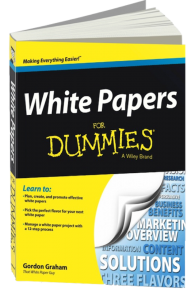PB Note: Gordon Graham is the reigning guru of white papers, and he sent me this great overview of the craft (and its exceptionally promising potential). Seriously consider picking up his brand-new new book, “White Papers for Dummies,†an excellent soup-to-nuts primer that’s been called a “must-read that contains priceless information you just can’t find anywhere else.” Take it away, Gordon!
***********************
It always surprises me that more B2B writers aren’t doing white papers.
As you may know, white papers are fact-based marketing documents used by B2B vendors to generate leads, build recognition, and nurture prospects through a complex sale. They typically run six to eight pages plus front and back matter.
If you’ve done any journalism, a white paper is much like a feature article for a magazine, only it pays 3 to 10 times as much.
In fact, the “average” fee for writing a white paper today is $4,200. Typical fees range from $3,000 to $6,000. Writers with domain knowledge or experience writing white papers routinely charge $5,000 to $7,000—or about $1,000 per page.
Why do companies pay so much?
1) B2B buyers expect them: Survey after survey pegs white papers as the #1 or #2 favorite content that prospects look at.
2) The competition has them: Any vendor that doesn’t can be out of the running for a million-dollar sale.
3) They work: White papers help B2B vendors sell billions of dollars worth of products and services every year.
All these factors add up to an unquenchable demand for these documents, which are now a standard part of the toolkit for any B2B marketer.
But writing a white paper can be challenging. It requires an unusual mix of writing to explain and writing to persuade. It demands that you find and assemble a mass of impeccable facts, figures, quotes, anecdotes and rhetorical devices into a compelling argument.
Not many writers know how to do all that or have had enough practice at this format. But any experienced business writer has all the essential skills it takes: researching, interviewing, writing smoothly, meeting deadlines, handling comments from reviewers, and so on.
A white paper is essentially a long-form, fact-based piece of marketing collateral. To write an effective white paper, you and your client need to identify a compelling topic, pinpoint a specific audience, gather persuasive proof points, construct a logical argument, and spin all this material into a 6- to 8-page narrative that holds readers’ attention and compels them to take the next step in the sales cycle for the associated product or service.
To do that effectively, you need to leave out any hype, buzzwords and marketing-speak. Focus on providing useful information, not a sales pitch. Help your readers understand an issue, solve a problem, or make a decision. Stick to the facts or to well-argued logic. Given today’s jaded prospects with their finely-tuned radar for hype, this low-key or “educational” approach can actually help “sell” a prospect far more effectively than outright promotional copy. This is why well-written white papers are crucial marketing tools for many B2B companies.
Okay, but how many clients need white papers anyway? Aren’t they all in software or some technology where you have to understand gobbledegook to get work?
Yes, white papers are popular in technology firms, but they’re now used in many other sectors. I’ve done them for clients in advertising, construction, healthcare, insurance, printing, sports—even children’s toys! Any B2B company selling something relatively new, relatively complex, or relatively expensive could benefit from a white paper.
Being extremely conservative and counting only the traditional users of white papers—B2B equipment manufacturers, software companies, and scientific and technical services—I found 454,244 potential clients in the U.S. alone. Adding in other countries from the developed world that use English—like Australia, Canada, and the UK—that climbs to more than 600,000.
I know for a fact that many of these companies are desperate for a writer who can help them tell their stories. I hear from one almost every day.
How can you learn more about writing them?
1. Go to websites of companies in your B2B specialty, and find half a dozen white papers to download and study.
Chances are, you’ll soon be thinking, “I can write better than this!” You’ll see how most white papers are not nearly as persuasive or compelling as they could be. That’s a great confidence booster when you’re starting out.
2. Visit my website to see dozens of free articles about every aspect of white paper writing.
3. Check out the free cheat sheet for my book here and a lot of extras here.
4. Join my LinkedIn group “Get More From Your White Papers” and post your question. The group members will do our best to answer you.
If you’re an experienced business writer or a laid-off journalist, give white papers a try. You’ll find a ready-made demand with high fees, and lots of interesting work to be done.
Have you done some white papers? If so, what was your experience like?
Did you find them to be easier or harder to do than you’d originally thought?
Have you been surprised at the quality (or lack thereof) of the samples you’ve seen?
If you haven’t yet tried doing white papers, what’s stopped you?
 Gordon Graham (a.k.a. That White Paper Guy) has written more than 175 B2B white papers for clients from Australia to New York City, on everything from selecting enterprise software to designing virtual worlds for kids, for everyone from tiny startups to Google.
Gordon Graham (a.k.a. That White Paper Guy) has written more than 175 B2B white papers for clients from Australia to New York City, on everything from selecting enterprise software to designing virtual worlds for kids, for everyone from tiny startups to Google.
 Check out his new book White Papers For Dummies
Check out his new book White Papers For Dummies
